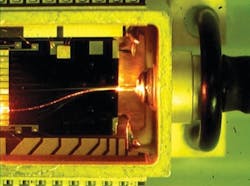NEUROSCIENCE/CELL BIOLOGY: Control of calcium ions by infrared pulsing promising for treatment
In work that could improve treatments for hearing and vision loss—and lead to devices to help maintain balance, treat movement disorders like Parkinson’s, and enable development of optical pacemakers—scientists at the University of Utah report using diode-generated infrared light to make rat heart cells contract and toadfish inner-ear cells send signals to the brain.1 The investigations complement work done at Vanderbilt University (Nashville, TN), Northwestern University (Evanston, IL), and the Massachusetts Eye and Ear Infirmary and Harvard Medical School (Boston, MA).
The heart cells in the Utah study were newborn-rat cardiomyocytes, which make the heart pump. The inner-ear cells are hair cells from oyster toadfish, which are well-established models for comparison with human inner ears and the sense of balance.
The heart cell study found that an infrared pulse lasting a mere one-5,000th of a second made mitochondria rapidly suck up calcium ions within a cell, then slowly release them—a cycle that makes the cell contract. “Calcium does that normally,” says Richard Rabbitt, a professor of bioengineering. “But it’s normally controlled by the cell, not by us. So the infrared radiation gives us a tool to control the cell. In the case of the [inner-ear] neurons, you are controlling signals going to the brain. In the case of the heart, you are pacing contraction.”
Rabbitt sees potential for optical implants to treat movement and balance disorders as well as vision and hearing loss. For instance, electrical deep-brain stimulation now is used to treat movement disorders such as Parkinson’s disease and essential tremor; Rabbitt is investigating whether optical rather than electrical deep-brain stimulation might increase how long the treatment is effective.
And today’s cochlear implants convert sound into electrical signals transmitted to eight electrodes—which can deliver only eight frequencies of sound, Rabbitt says. “A healthy adult can hear more than 3,000 different frequencies. With optical stimulation, there’s a possibility of hearing hundreds or thousands of frequencies instead of eight.”
1. S. M. Rajguru et al., J. Physiol. 6 (589): 1283–1294 (2011).
More BioOptics World Current Issue Articles
More BioOptics World Archives Issue Articles

